Car and Driver’s Ten Favorite Automobiles at the 2014 Pebble Beach Concours d’Elegance
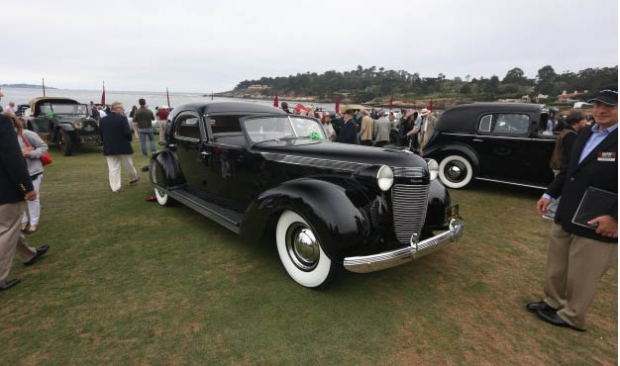
Car and Driver has posted their ten favorite automobiles that participated in the 2014 Pebble Beach Concours d'Elegance. Check out the automobile listed after the Best of Show winner.
Enjoy,
Howard Kroplick
2014 Pebble Beach Concours d’Elegance: Best of Show, Nine More Favorites, Plus a Mega-Gallery
Car and Driver
August 18, 2014 at 7:09 pm by Aaron Robinson, Davey G. Johnson, and Erik Johnson | Photography by Marc Urbano
If our little gathering here seems kind of heavy on Ferraris, understand that this year’s Pebble Beach Concours d’Elegance was itself kind of heavy on Ferraris. In addition to a special class of 1950s and ’60s Testa Rossas—there were 20 on the 18th fairway, all together worth perhaps half a billion dollars—a Ferrari won the Best of Show award for the first time in the marque’s illustrious history. You can read about that car below, as well as nine more favorites from our time spent walking the lawn. Most of the rest of the field can be seen in our gallery—enjoy.
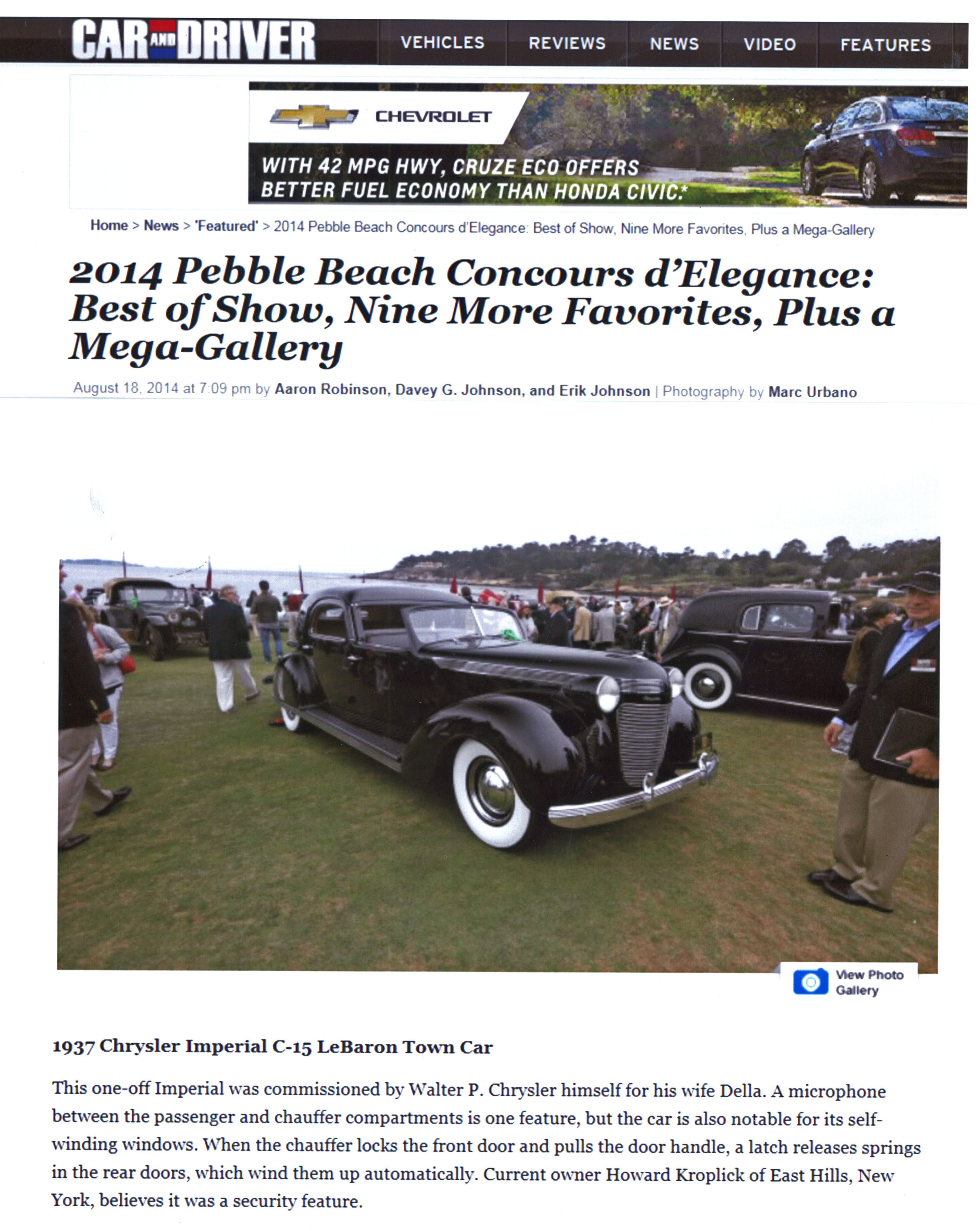
Best of Show: 1954 Ferrari 375MM Scaglietti Coupe
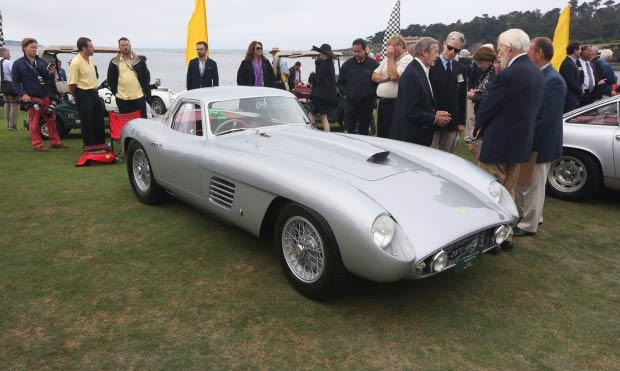
As mentioned, the crowning of Jon Shirley’s spectacular car marks the first time ever that a Ferrari has taken home the top prize, and it’s also the first time since 1968 that a postwar car has done so. This car was originally ordered by Italian filmmaker Roberto Rossellini and bodied as a competition Spyder by Pinin Farina. It wasn’t driven much yet, it was still in an accident serious enough to require new sheetmetal; Scaglietti was commissioned to provide the replacement aluminum body, its first work on a Ferrari chassis. This car traded hands a few times after it left Rossellini’s care, ultimately being discovered essentially abandoned in an underground garage in Paris. The car was fully restored in 1995 and has previously taken home class-winner honors from Pebble Beach in 1998.
1937 Chrysler Imperial C-15 LeBaron Town Car
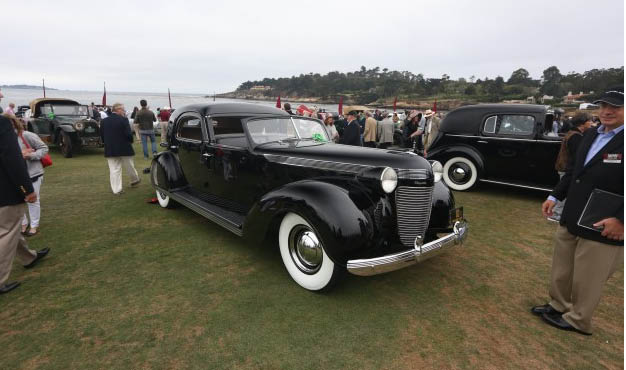
This one-off Imperial was commissioned by Walter P. Chrysler himself for his wife Della. A microphone between the passenger and chauffer compartments is one feature, but the car is also notable for its self-winding windows. When the chauffer locks the front door and pulls the door handle, a latch releases springs in the rear doors, which wind them up automatically. Current owner Howard Kroplick of East Hills, New York, believes it was a security feature.
1967 Ferrari 206 Dino Competizione
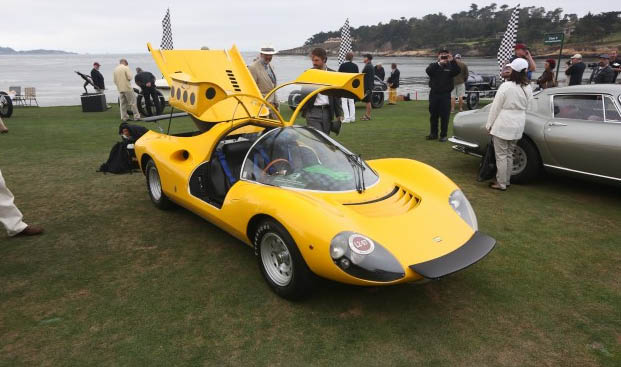
“Andrea, if it stays here, it’s gonna turn to cement,” said Jim Glickenhaus to Andrea Pininfarina of the 206 Dino Competizione. Built in 1967, the car had been sitting in Pininfarina’s museum for decades. Nothing Glickenhaus owns is in danger of turning to cement. The man road-registers and drives his acquisitions and creations. His P4/5, which debuted in 2006, once memorably paced a 24 Hours of LeMons race. Although Pininfarina was initially unwilling to sell, Glickenhaus eventually wore him down.
On this afternoon it took its place on the lawn, in all its blazing, sci-fi cartoon glory. The 206 Competizione aesthetically promised a Plexiglas future we never quite got, but it influenced generations of Ferraris to follow. It still manages to overshadow most of them.
1962 Maserati Tipo 151 Coupé
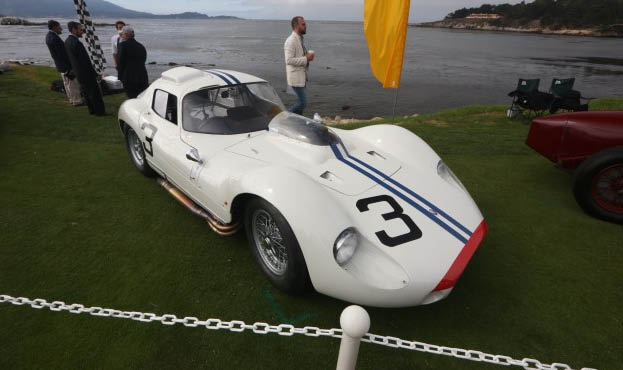
While leafing through the program detailing the participants in this year’s vintage races at Mazda Raceway Laguna Seca, we came across a picture of a Birdcage coupe. We were intrigued, having never seen such a car before. As it turns out, it’s not a Birdcage, but it’s close: The Tipo 151 followed closely on the heels of the famous Birdcage cars, and its styling—especially the swollen fender tops—is immediately reminiscent of the cars it succeeded. This car unfortunately didn’t make it to the grid out at the track, but we were pleasantly surprised to see it sitting on the lawn at Pebble Beach as part of the special class celebrating Maserati’s centennial.
The Tipo 151 was created at the behest of Briggs Cunningham for the 24 Hours of Le Mans. Three were originally constructed, and this is the only survivor, the other two having been lost to major accidents. A 4.0-liter V-8 and four Weber carburetors propelled the tube-frame car to more than 185 mph. Unfortunately, the Tipo 151’s complicated rear suspension proved problematic and none of the examples finished the race.
1959 Ferrari 250 TR59/60 Fantuzzi Spyder
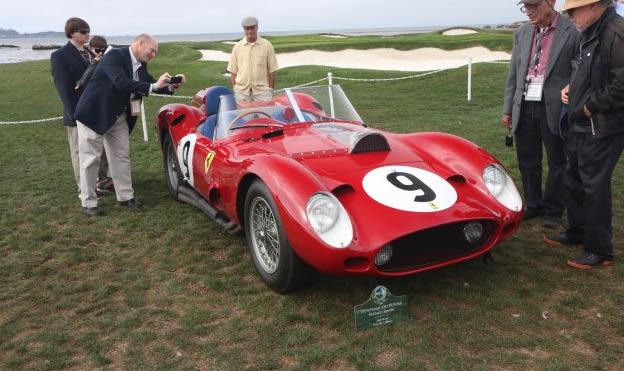
For the 1960 season, Ferrari updated its TR 59-model cars for the first part of the year. Well-suited to endurance racing, the big Testa Rossas fought the slight, lovely Maserati Birdcages. A spate of TR prancing horses led Ferrari to a manufacturer’s championship in 1960, sealed by a 1-2 win at the 24 Hours of Le Mans.
The car featured here, John Mozart’s TR59/60 was entered in that race but wound up with a DNF. Later run in the United States in SCCA events and burdened with nonoriginal engines including a Ford V-8, the car was eventually purchased by the current owner, reunited with its original Colombo V-12, and restored in the early aughts by Paul Russell of Massachussetts. We picked it over the other Testa Rossas lined up at Pebble due to its light patina earned over a decade of road use. There’s no point in a Ferrari that just sits, and this one obviously doesn’t.
1922 Packard Twin Six

This original, unrestored “cape-top” touring car belonged to Agnes Jane Reeves Greer, the Pittsburgh heiress to a steel fortune who married another steel magnate. No mere dilettante, Mrs. Greer held 18 patents herself for industrial processes and designed the Packard’s body herself, giving the specifications to the Brunn coachworks in Buffalo, New York, which built the body atop Packard’s top model, which had a 424-cubic-inch 60-degree V-12. The car still bears Mrs. Greer’s initials. It was donated by the family to a car museum in Canton, Ohio, and remained there until 2010, when collector and classic-car-dealer Mark Hyman of Saint Louis purchased it. The Packard won the preservation class for prewar unrestored cars this year.
1948 Riley 2½-Litre Walter Kong Transformable Saloon
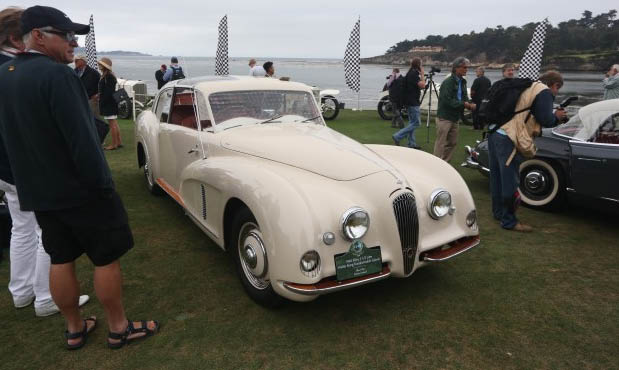
This car was shown as part of the postwar preservation class at Pebble, one of our favorite groupings that covers unrestored cars. It was bodied by Walter Kong, a Swiss coachbuilder who purchased the car himself to show off his talents at the 1949 Geneva auto show. Kong reached back a couple of decades for the Art Deco shapes and lines, and he also found inspiration in aeronautics. The roof has four separate clear panels, two of which are removable and replaceable by light-diffusing silk cloth. Kong intended to put the car into production, but the handmade details that make it so amazing today meant it was too expensive for that period, and it remained a one-off.
1938 Delahaye 135M Guilloré Cabriolet
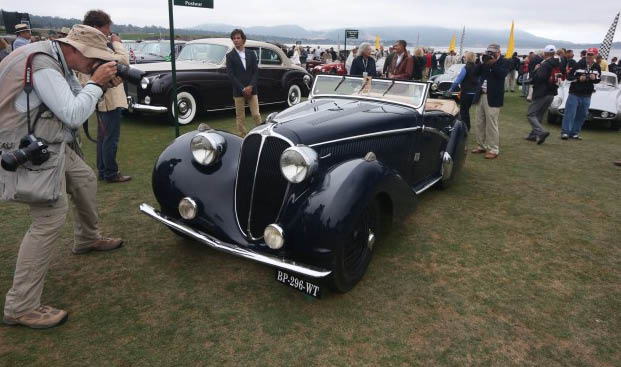
Delahaye’s 135M Competition chassis was shorter and lower than the French automaker’s other units. Only two cabriolets were constructed, and this is the only one bodied by the Guilloré concern. We stumbled across it in the midst of a sea of gaudier, larger, more imposing machines and were struck by its perfect lines, triple wipers, and signs of wear. It’s a neither-here-nor-there car, invited to the event but shown without competitive intent. An older restoration renders it ineligible for the survivor classes, and the wear and tear means it won’t win any awards for extra shininess. We love it just as it sits, and we’re pleased that Dutch owner Jack Braam Ruben brought it to California just for us to ogle.
1938 Tatra T97 Aerodynamic Sedan
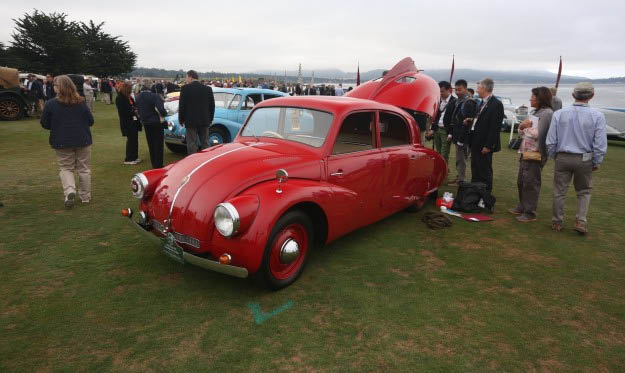
The T97—built between 1936 and 1939—was a scaled-down, more affordable version of the larger T87. Just over 500 examples were built; the limited production run was a direct result of the Nazi government’s preference for Ferdinand Porsche’s Volkswagen Beetle, which used many of the same concepts—aerodynamic styling, a rear-mounted horizontally opposed engine—but was developed after the Czechoslovakian Tatra. The T97’s body is constructed from pressed steel with a central tube for strength, while power comes from a 1.7-liter flat-four making 40 horsepower. This example was restored in the early 1990s by Ecorra, a Czech Tatra specialist, and currently resides in the Lane Motor Museum in Tennessee.
1960 Ferrari 250GT SWB Bertone Berlinetta Speciale
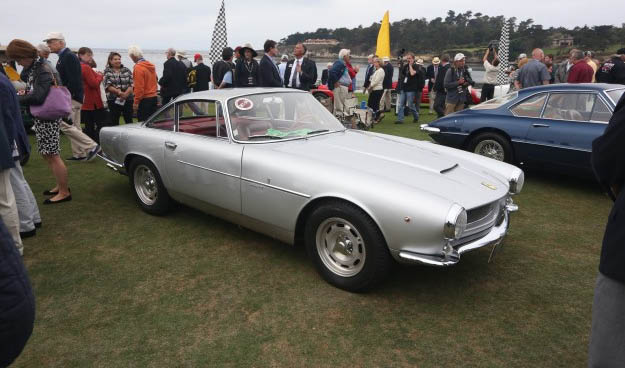
This odd Ferrari one-off gives a tantalizing taste of what Ferrari’s cars would have looked like if their preferred design house had been Bertone instead of Pininfarina. With contemporary Pininfarina cars selling for tens of millions, the market seems quite happy with things as they are, but this car—commissioned by a Genoa, Italy, booze merchant and friend of Enzo Ferrari—is conservatively beautiful with its slightly familiar, Alfa Romeo 2600 coupe–like lines (a Bertone design from 1961). The car was penned by Giorgetto Giugiaro, just 21 at the time, and featured a brushed stainless roof. Interior oddness includes a pistol-grip shifter and center-mounted gauges canted toward the driver.

Comments
The Chrysler look’s great, good luck. Congratulations at Pebble Beach
Interesting only two pre WWII American cars were chosen by C & D magazine. That magazine is known for its coverage of boy racer sports cars, for them to choose a formal town car as a favorite is astounding! Congratulations Howard!
Also note that both the Chrysler and Packard were worked on by the same shop and wound up in the same semi trailer for their trip to California and the concours. The Packard had major overheating issues before it arrived at the shop which were rectified and it and the Chrysler both drove the 85 mile tour over hill (some pretty big hills) and dale before the show. Automotive Restorations in Lebanon, NJ , its owner Steve Babinsky, and his amazing crew of craftsmen have to be one of the top shops in North America.
Howard,
Mazel tov!!! The car is magnificent. The award couldn’t have gone to a nicer guy.
Again, congratulations.
Roger